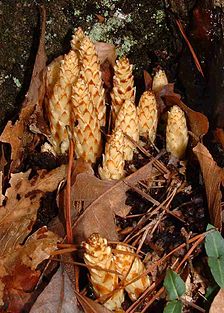|
Conopholis americana
Conopholis americana, the American cancer-root, bumeh or bear corn, is a perennial,[3] non-photosynthesizing (or "achlorophyllous") parasitic plant. It is from the family Orobanchaceae and more recently from the genus Conopholis but also listed as Orobanche, native but not endemic to North America. When blooming, it resembles a pine cone or cob of corn growing from the roots of mostly oak and beech trees.[4][5] DescriptionConopholis americana is parasitic on the roots of woody plants, especially oaks (genus Quercus) and beech (genus Fagus).[3] The only part of the plant generally seen is the cone-shaped inflorescence,[5] which appears above ground in spring.[6] The entire structure is a yellowish color, turning to brown.[3] It achieves heights of 10 centimeters (4 in) to 20 centimeters (8 in) tall.[7] Stems and leavesThe plant has stout and unbranched 1.3 centimeters (0.5 in) to 2.5 centimeters (1 in) thick stems.[8] Since C. americana does not photosynthesize[5] it also does not have true leaves; it has instead simple, ovate, tiny scales[3] 1.3 centimeters (0.5 in) long and brown, which appear at the base of each flower.[7] FlowersConopholis americana produces spikes of yellow to cream flowers densely crowded all around the stem.[7] Each flower is 5-parted, 8 millimeters (0.3 in) to 13 millimeters (0.5 in) long, tubular with a swollen base and facing downwards.[8] As the flowering spike matures it begins to wither and becomes brown throughout the summer and often persisting through the winter, by which time it has become shriveled and black. There is no noticeable floral scent.[7] Fruits and reproductionEach flower is replaced by a seed capsule that is longer than it is wide and contains many small seeds. This plant spreads to new locations by reseeding itself.[7] RootsThe root system is parasitic on the roots of oak trees (Quercus spp.); dependent on the host tree for its nourishment, the suckers of the parasitic roots cause the formation of large rounded knobs on the roots of the host tree.[7] DistributionThe plant is found growing on roots in wooded ravines[3] in every state of the United States east of the Mississippi River.[1] While widely distributed, it is uncommon. Native:
It is considered an exploitably vulnerable species in New York, a threatened species in New Hampshire and a special concern in Rhode Island.[1] References
 External links
|
||||||||||||||||||||||||||||||||||||||||
Portal di Ensiklopedia Dunia


